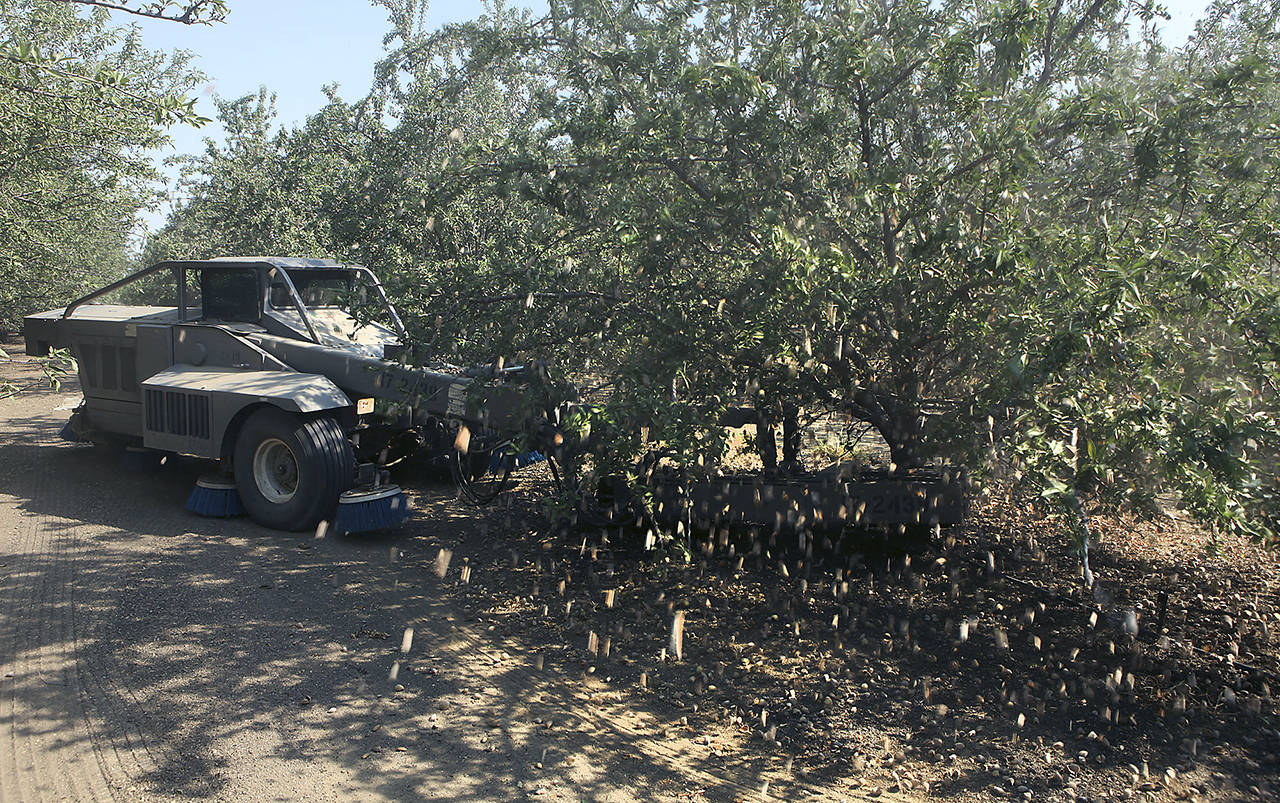SACRAMENTO, Calif. — In California’s Central Valley, money does grow on trees.
Almonds constitute a $5.6 billion industry, and 2.26 billion pounds were shipped from California last year to be roasted and salted, or turned into anything from frothy, barista-friendly almond milk to marzipan sold on the streets of Berlin.
From seed to tree to nut, almond growing is a 25 year, water-intensive process.
The almond tree first starts to bear nuts around age 4 or 5, and produces yearly profitable harvests of nuts for the next 20 or so years.
“An almond tree is like a little baby,” said Carlos Rodriguez, a laborer at Done-Again Farms in Arbuckle. “You need to take care of that tree from the bottom until it dies.”
Fifty years ago, almond grower David Phippen’s father marked down on his calendar to open the floodgates of his irrigation canal every 30 days.
“He irrigated every 30 days whether he needed to or not,” Phippen said. “He farmed by the calendar.”
Every month, the locks on the canal turned, and thousands of gallons of water would sweep across the orchard, soaking every inch of soil.
Nowadays, at Done-Again Farms in Arbuckle, almond grower John Monroe Sr. employs an intricate irrigation system that’s highly sensitive to the orchard soil’s moisture levels.
“Each acre takes 4 feet of water to bring in a crop,” Monroe said. “You get a foot of it from rain if you’re lucky.” The other 3 feet must come from irrigation.
During the wet season, from December through February, orchard irrigation systems lie fallow.
Then, 1 million acres in California suddenly bloom with delicate white flowers, and growers unload thousands of boxes of bees, imported from all over the country.
Growers deploy one or two hives per acre, each of which costs between $180 and $200 per season, unleashing the bees only on the sunniest days. Bees are so essential to almond production, that two summers ago in Fresno, thieves stole 2,500 hives worth $1 million.
“Every bee in the country comes to California for a winter vacation,” Monroe said.
After four or five weeks of the pollination craze, the trees settle into a five-month growing phase, when the fuzzy green almond hulls slowly ripen and harden throughout the hot, dry summer months.
At David Phippen’s farm, Travaille and Phippen, it’s nearly time for the harvest.
In mid-August, a yellow tractor will drive through the neat rows of trees, stopping at each tree. Lobster-like claws will extend from the machine, gripping the base of the tree and vigorously shaking it. Almonds will rain down, and dust will blow.
In the next few days, another machine, called a sweeper, will project a circular red fan that sends the resting almonds flying into a neat row in the middle of each row of trees.
From there, another tractor arrives to collect the almonds, sucking the nuts into a conveyor belt that stores them inside the tractor.
The nuts are then transported to the hulling and shelling facility, on an enormous lot directly adjacent to the orchards at Travaille and Phippen.
The nuts first pass through an enormous filter, which removes the large sticks and stones. The almonds then pass through a series of machines on a conveyor belt and are hulled and shelled. They emerge from the facility naked, stacked into enormous piles as tall as an average adult, ready to be sorted.
At the Travaille and Phippen processing facility, next door to the hulling and shelling, the nuts are sorted by size, and then by a robot, the only one of its kind.
The robot reaches a long, jointed arm, painted red, to select and pick out the nuts that are chipped, cracked, or display an abnormal color. First, the nuts are rapidly photographed by the robot, and those with impurities are picked out by the machine with long, dextrous fingers.
Even after this intense vetting process, each nut is scrutinized by employees, who sit at stations wearing blue gloves, running their hands over each nut to ensure that only the most perfect ones make it into the final pile.
The final group of almonds, which exhibit that perfect, characteristic taper, and a deep, warm woody color, are packaged neatly into white sacks in the packing and shipping facility, where they await foreign destinations such as India, Japan, China and Germany.
Only 10% of Travaille and Phippen nuts stay in the United States. However, at Done-Again Farms, the nuts are shipped straight to Blue Diamond in Sacramento.
Blue Diamond is an almond cooperative, an expansive umbrella organization that covers 3,000 almond growers in California. It operates via an elected board of 11 growers and distributors who represent nine growing districts and serve three-year terms. John Monroe is the director of the Arbuckle district.
Nearly every grocery store in the United States carries its signature Almond Breeze almond milk and its roasted almonds.
“Every major brand name company like cereal or granola bars, if they have almonds in them, chances are they’re getting those almonds from Blue Diamond,” said spokeswoman Alicia Rockwell. “We process them —we may roast them, slice them, or turn them into flour or butter.”
The almonds are trucked into Sacramento from all over California, and within its headquarters at 1802 C St., they are blanched, sliced, roasted, or turned into paste for almond milk and almond butter, or powdered into flour or meal.
Almonds have proved enduringly popular in America. They are heart healthy, full of omega-threes, and promote skin health. At the moment, they represent California’s third most valued commodity, worth $5.6 billion.


